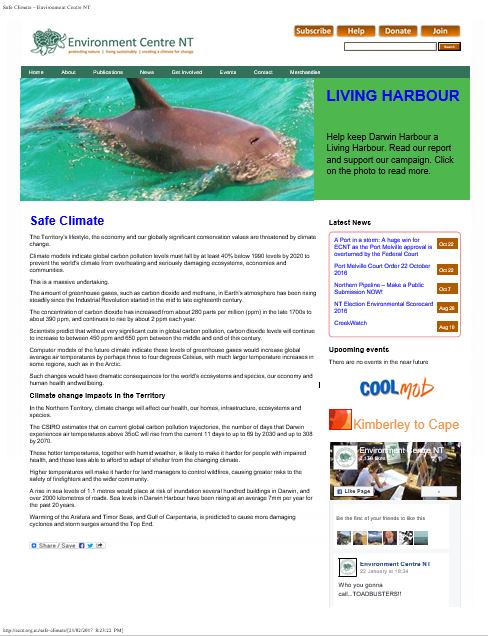We have a lot of sunshine in the Territory. And we plan to use it. Safe Climate: Updates on Safe Climate campaigns and programs
• We Did It Darwin! December 2 2015: Hundreds played their part to ensure Darwin was on the map for the Peoples Climate March – they helped achieve Darwin’s biggest climate march ever! In sweltering heat, over 500 people marched from Stokes Hill Wharf to the Darwin Waterfront to call for…
• Regarding comments made in Parliament: September 17 2015: Dear friends, Unfortunately the NT Mines and Energy and Planning Minister Dave Tollner made some outrageous comments about the Environment Centre in parliament yesterday. We feel moved to respond in an open letter given that he has used parliament time…
• Scoping an Australia – Asia Interconnector to grow regional renewable energy and energy security: January 31 2014: The Environment Centre NT is partnering with research, consulting, power distribution and renewable energy organisations in Australia and Indonesia to host a workshop to scope connecting the electricity grids in Northern Australia and Environment Centre NT Southeast Asia to catalyse the generation and…
NT Solar Summit 2013: May 21 2013: NT Solar Summit 2013, Wednesday 12 June 2013, 8 am – 2pm, Darwin Convention Centre Free event. All welcome. Read more and download the flyer. The Northern Territory is a global solar hotspot! The NT Solar Summit 2013 will bring. Find out more »
• Safe Climate: March 16 2012: The Territory’s lifestyle, the economy and our globally significant conservation values are threatened by climate change. Climate models indicate global carbon pollution levels must fall by at least 40% below 1990 levels by 2020 to prevent the world’s climate from…
Safe Climate
The Territory’s lifestyle, the economy and our globally significant conservation values are threatened by climate change. Climate models indicate global carbon pollution levels must fall by at least 40% below 1990 levels by 2020 to prevent the world’s climate from overheating and seriously damaging ecosystems, economies and communities. This is a massive undertaking. The amount of greenhouse gases, such as carbon dioxide and methane, in Earth’s atmosphere has been rising steadily since the Industrial Revolution started in the mid to late eighteenth century. The concentration of carbon dioxide has increased from about 280 parts per million (ppm) in the late 1700s to about 390 ppm, and continues to rise by about 2 ppm each year. Scientists predict that without very significant cuts in global carbon pollution, carbon dioxide levels will continue to increase to between 450 ppm and 650 ppm between the middle and end of this century. Computer models of the future climate indicate these levels of greenhouse gases would increase global average air temperatures by perhaps three to four degrees Celsius, with much larger temperature increases in some regions, such as in the Arctic. Such changes would have dramatic consequences for the world’s ecosystems and species, our economy and human health and wellbeing.
Climate change impacts in the Territory
In the Northern Territory, climate change will affect our health, our homes, infrastructure, ecosystems and species. The CSIRO estimates that on current global carbon pollution trajectories, the number of days that Darwin experiences air temperatures above 35oC will rise from the current 11 days to up to 69 by 2030 and up to 308 by 2070. These hotter temperatures, together with humid weather, is likely to make it harder for people with impaired health, and those less able to afford to adapt of shelter from the changing climate. Higher temperatures will make it harder for land managers to control wildfires, causing greater risks to the safety of firefighters and the wider community. A rise in sea levels of 1.1 metres would place at risk of inundation several hundred buildings in Darwin, and over 2000 kilometres of roads. Sea levels in Darwin Harbour have been rising at an average 7mm per year for the past 20 years. Warming of the Arafura and Timor Seas, and Gulf of Carpentaria, is predicted to cause more damaging cyclones and storm surges around the Top End

